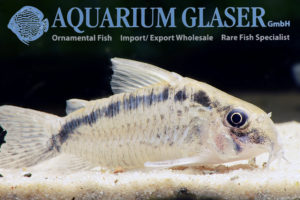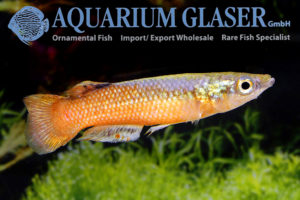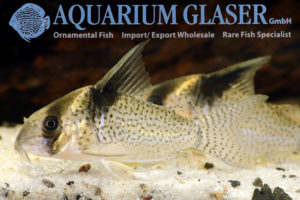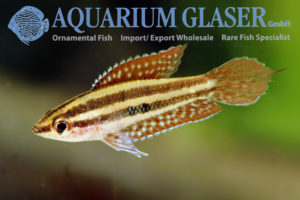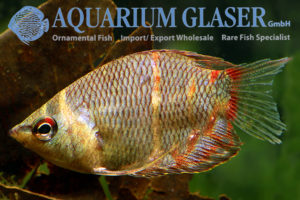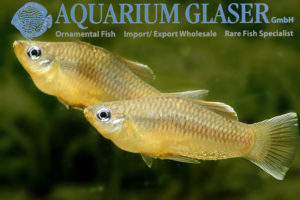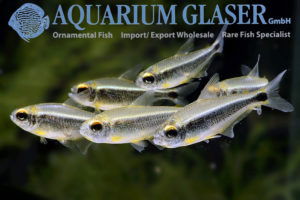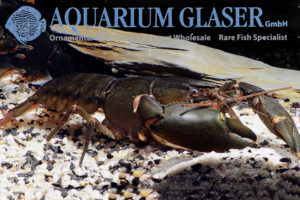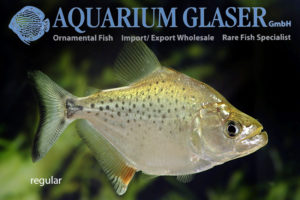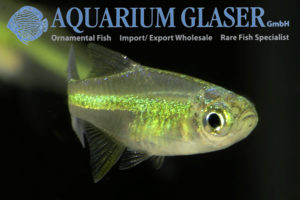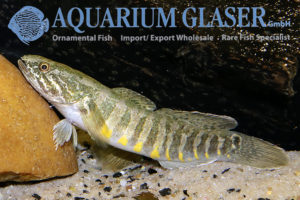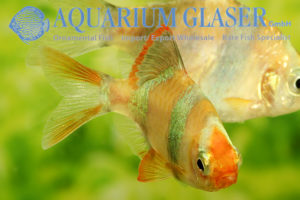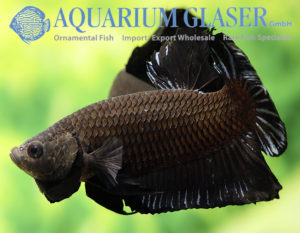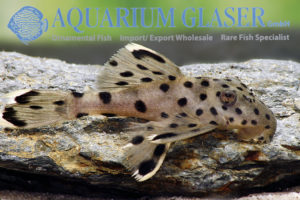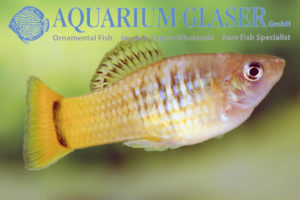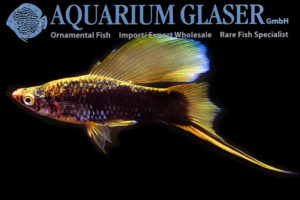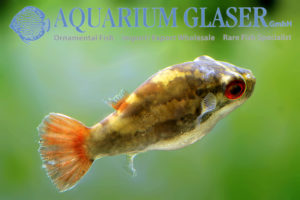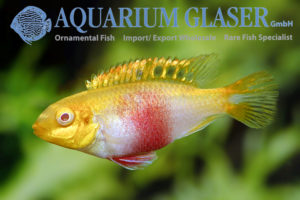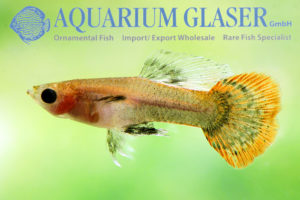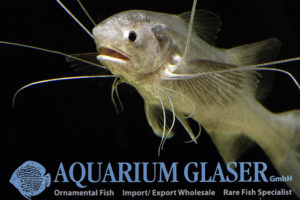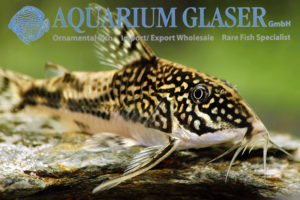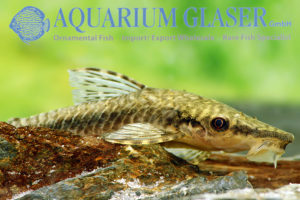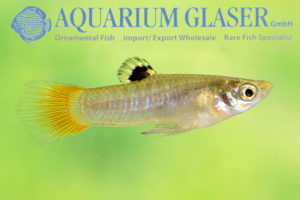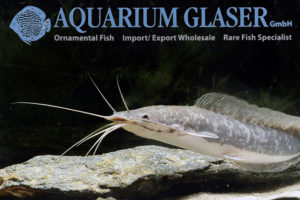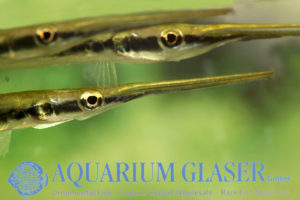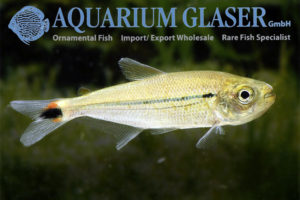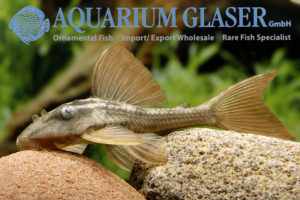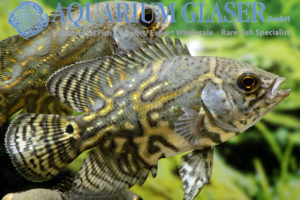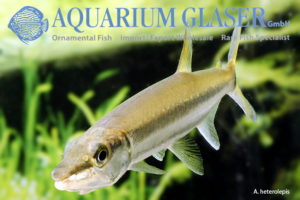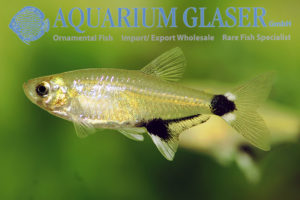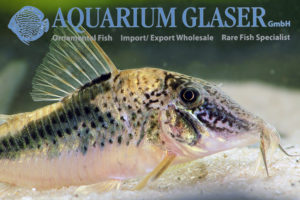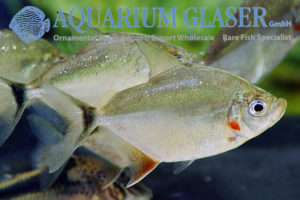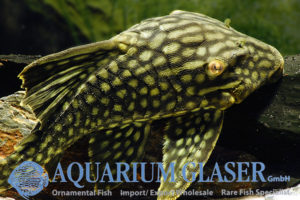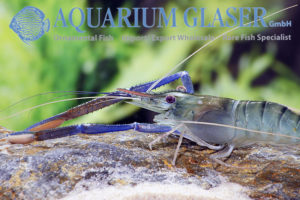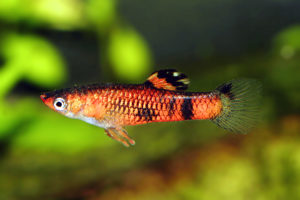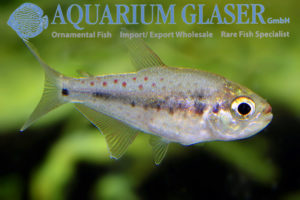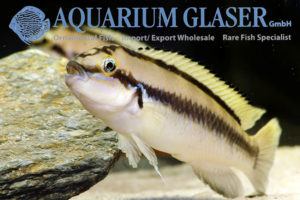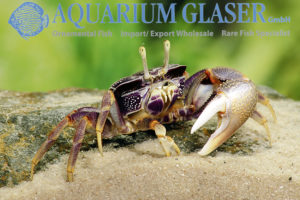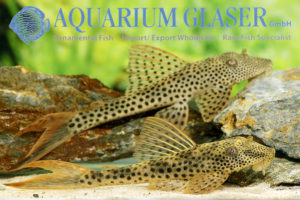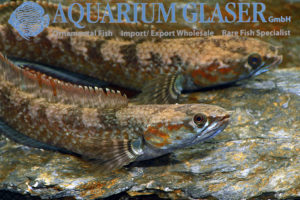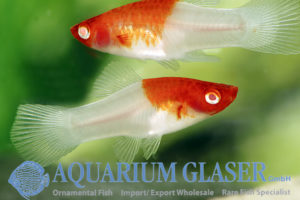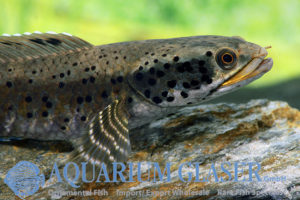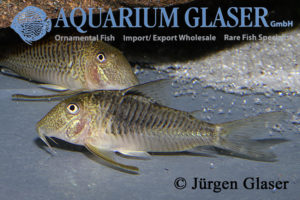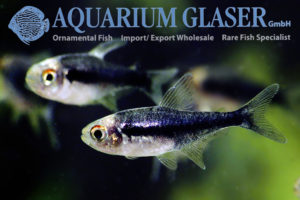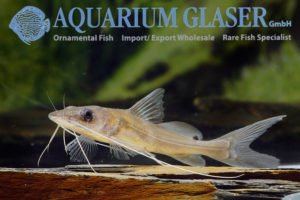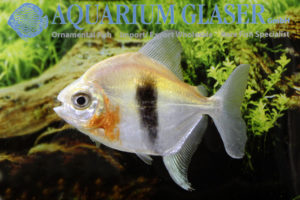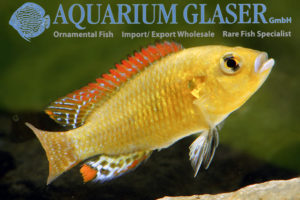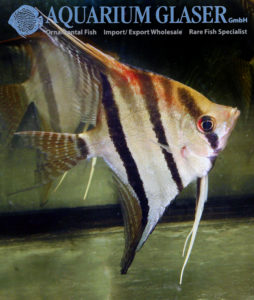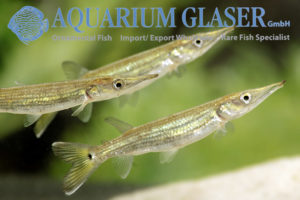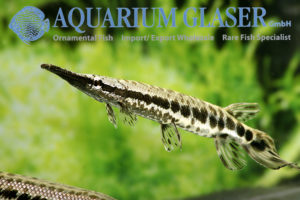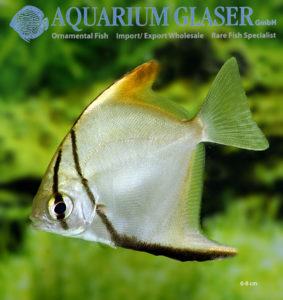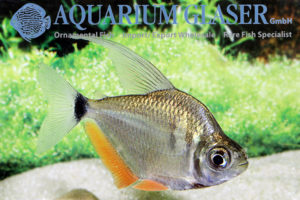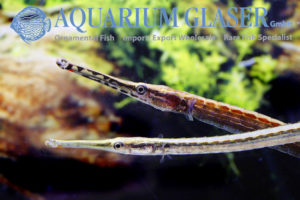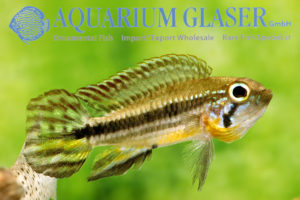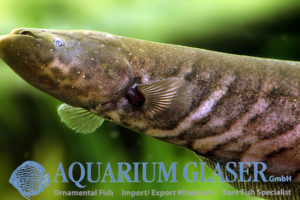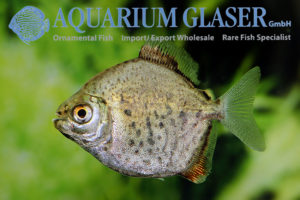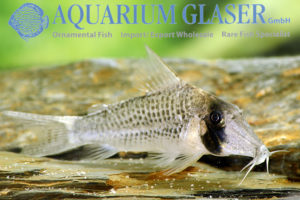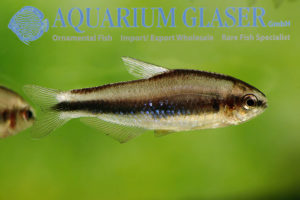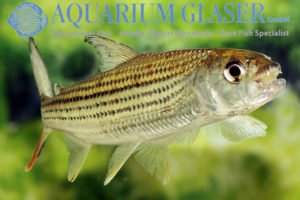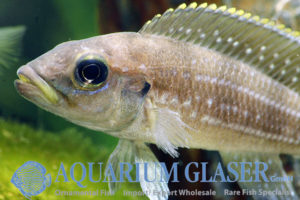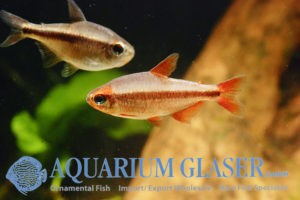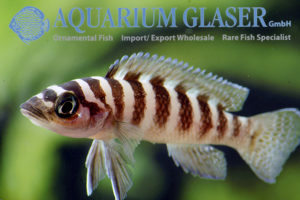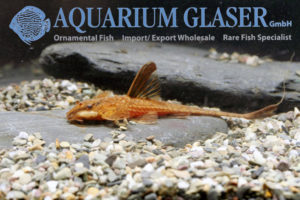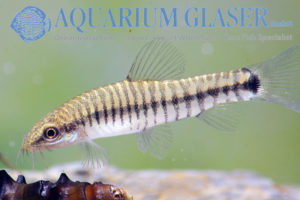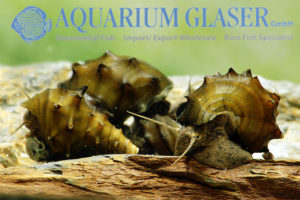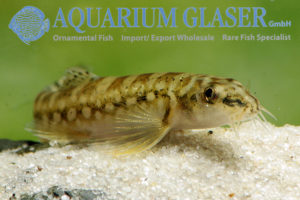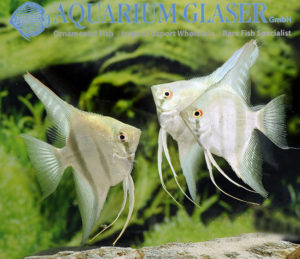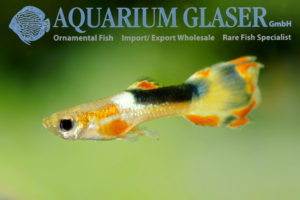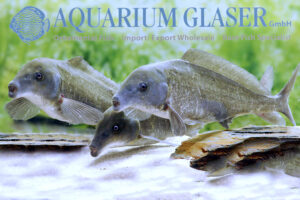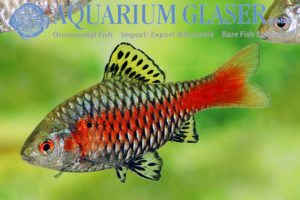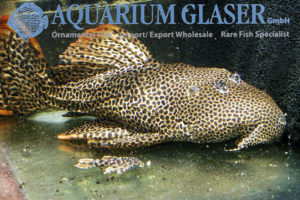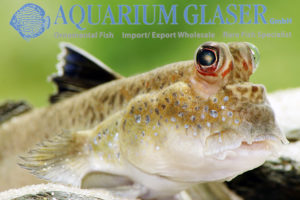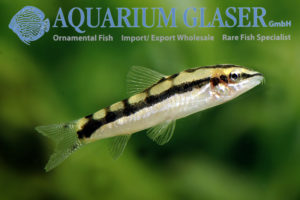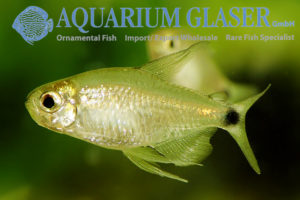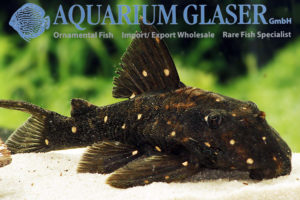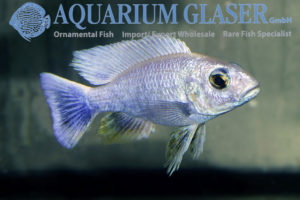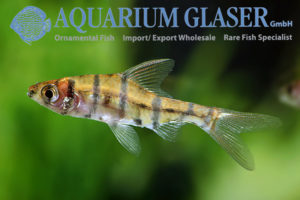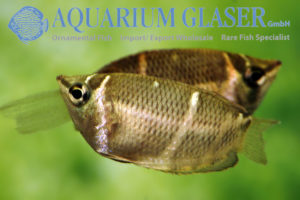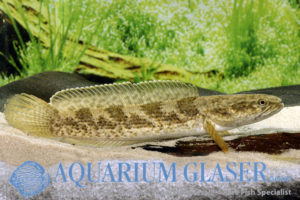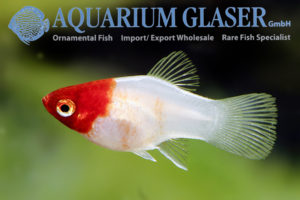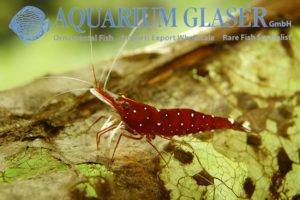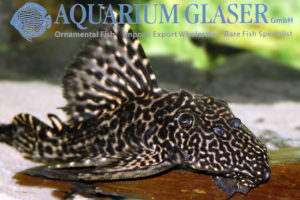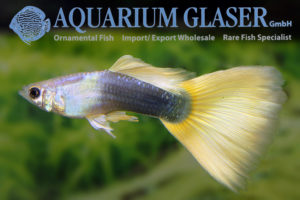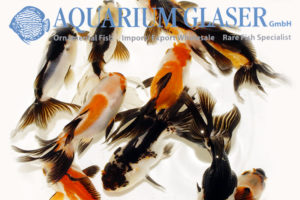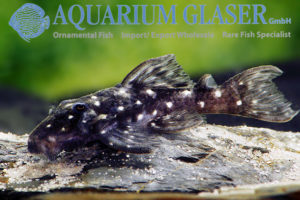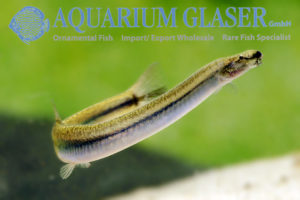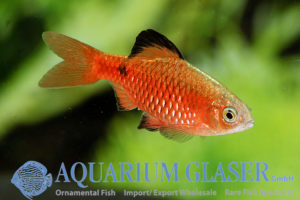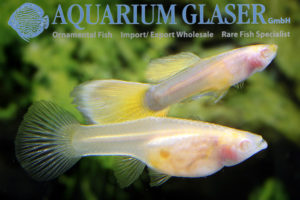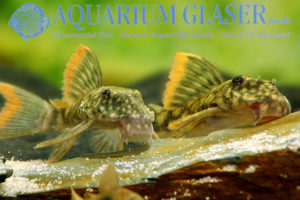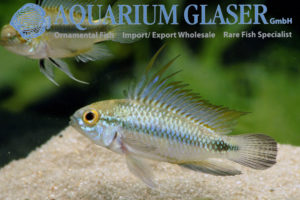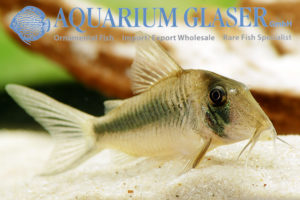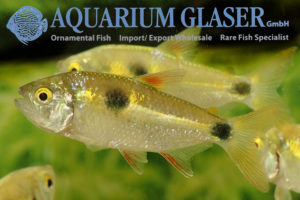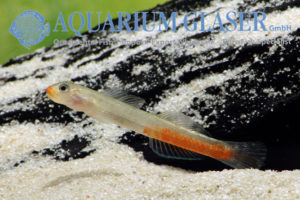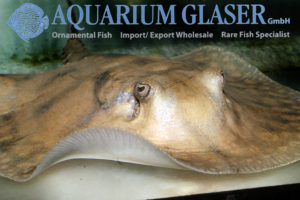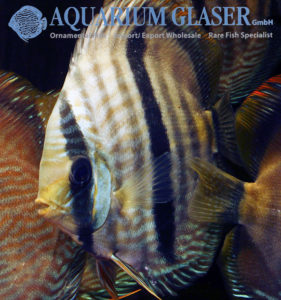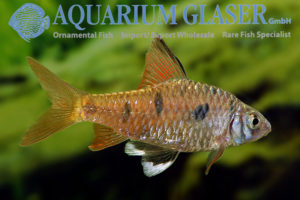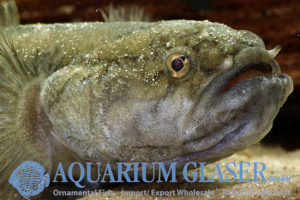Once again we were able to import a new catfish, whose identity raises many questions. The fish were offered to us as Corydoras evelynae, a species that was described by only one specimen with a very inaccurate location (“upper Solimoes”, which includes an area larger than Germany). Our new imports were collected in the surroundings […]
Fish Archive (3089)
-
-
Pachypanchax sakaramyi – one of the rarest fish in the world
Although the species Pachypanchax sakaramyi – it originates from the Sakaramy River on Madagascar – was described as early as 1928, it could not be found for decades afterwards and even was referred to the realm of legends. It was not until the 1990s that they were found again. From these animals (5 pairs), which […]
-
Corydoras sp CW 98
This beautiful Corydoras belongs to a scientifically undescribed species. It originates from the upper Rio Negro in Brazil. Because of the bright orange neck spot it is usually misidentified as Corydoras burgessi, which also comes from this region, especially as C. burgessi has a very variable pattern and there are also spotted colour variants of […]
-
Parosphromenus linkei
The magnificent licorice guramis (Parosphromenus) have experienced a species explosion in recent years. Until 1979 only three species were known, today there are 20 scientifically described species and some more undescribed ones are already known in the hobby. Unfortunately, many are threatened with extinction because they live in peat swamps and these habitats are drained […]
-
Sphaerichthys osphromenoides
From Indonesia we received beautiful, very large and strong chocolate Guramis (Sphaerichthys osphromenoides). Unfortunately the exact place of origin is not known, but we suspect that they come from the Indonesian part of Central Borneo, Kalimantan. Particularly noticeable in the animals is their high red portion in the coloration, which is however somewhat different with […]
-
Priapella compressa
The Blue-eyes from Mexico are closely related to the Knife-bellies (Alfaro). Like these, the males of Priapella have a massive keel along the underside of the tail. All Priapella attract attention by their blue, shining eyes. They are powerful swimmers who appreciate a good current. In nature they live close to the surface in clear […]
-
Moenkhausia heikoi
For the first time we could import, even if only in very limited numbers, this tetra from the Rio Xingu described only in 2004. The animal became known in 2001, when Rainer Stawikowski presented the fish as “Hemigrammus sp. Xingu” in the journal DATZ. The scientific description took place in 2004, twice and almost simultaneously: […]
-
Cherax sp. „Black Scorpion“
Along with other species of Cherax,, which we have already introduced to you, we have received the Cherax sp. “Black Scorpion”. They are very attractive animals whose care and breeding does not differ significantly from that of the previously known Cherax forms from New Guinea. For our customers: The animals have code 481473 on our […]
-
Serrasalmus compressus – a very interesting piranha from Peru
Recently we obtained a shipment of piranhas from Peru. The fish are 5-9 cm long. At the first glimpse the shipment could be told apart into two phenotypes. First, there were fish with comparatively small spots, a lot of red coloration in the anal fin and a comparatively thin black border on the caudal fin. […]
-
Microdevario kubotai
Microdevario kubotai This extraordinary beauty is a real dwarf (maximum length around 2.5 cm). It originates from the southwestern province of Ranong in Thailand (which forms a border to Burma) and is now available in perfect quality. Initially this fish has been described in the genus Microrasbora, but has been transferred together with M. gatesi […]
-
Bostrychus zonatus
Bostrychus zonatus is a sleeper goby and becomes about 15 cm long. They are predatory fish, which should therefore only be kept together with species that have at least half the body length of the gobies, larger is safer. The beautiful animal is widespread in fresh and brackish water in New Guinea and northern Australia. […]
-
Puntigrus anchisporus (= Barbus tetrazona) Gold Green Stripe
About 10 years ago the breeders suddenly focussed again on the old-known tiger barb, whose scientific name is, by the way, Puntigrus anchisporus. Puntigrus tetrazona is a species that is practically never seen in the aquarium, the edges of its fins, which are coloured red in the tiger barb, are black. One of the new […]
-
Betta splendens Black Knight Pla Kat
Black knights – that’s what Thai breeders call this beautiful, short-finned fighting fish, which we can offer at the moment. The animals are colored so intensively black that you can’t see any detail on normal exposed photos, they just look like a black surface. But if you overexpose strongly, you can see that the black […]
-
L264 Leporacanthicus joselimai German bred
Leporacanthicus joselimai (L264) comes from the Rio Tapajós in Brazil and grows 15-20 cm long. It belongs to the carnivorous species of suckermouth catfish and should therefore be fed with a wide range of feed, such as frozen food, granules, flakes, etc.. Since most of the food is eaten at night, it is necessary to […]
-
Xiphophorus variatus “Puente Escalanar”
Once again we can offer a extremely beautiful wild strain of the variatus platy in good numbers as German offspring. The ancestors of these animals were collected in 2002 in Puente Escalanar, Veracruz, Mexico by private hobbyists and brought along. Since then, the animals have enthused mainly the community of friends of livebearers; to our […]
-
Xiphophorus hellerii „Hamburg Highfin“
Only very rarely one of the most beautiful breeding forms of the swordtail comes to us: the black Simpson with orange fins. Among fish lovers Bayreuth is known as the spade for this very distinctive swordtail breeding form and is called “Bayreuth Cross”. In Germany, this variant was first exhibited in 1968 (report by the […]
-
Carinotetraodon irrubesco
Pufferfish are most often thought to be brackish water fishes. But there do exist indeed species that are adopted to totally fresh water. Some of them even live in the very soft and acidic waters of the forests. Among the latter are the species of Carinotetraodon from Indonesia; we currently could import once more C. […]
-
Pelvicachromis pulcher Albino
Breeding forms are like certain foods: you like them – or not. But it is a fact that the aquarium hobby, like all other areas of domestic animal and plant care, cannot get along without breeding forms. The albino of the krib, Pelvicachromis pulcher, is a breeding form whose charm is not obvious at […]
-
Guppy “Red Smoke”
Glasbelly guppies do not produce guanine due to a genetic peculiarity – this is the silver dye that makes fish glisten. This makes them more or less transparent, as the guanine normally reflects the light and prevents transparency like a mirror. Mostly Glasbelly guppies are bred as albinos. If the black melanin also falls away, […]
-
Polynemus paradiseus
Currently we have a really unusual species of fish in our fishhouse: Polynemus paradiseus. The Polynemidae family is almost unknown to hobbyists, despite the fact that over the centuries 96 species have been described, 42 are still valid, and these fish are important food fishes in their home range. Two species of the genus Polynemus […]
-
Scleromystax barbatus
No doubt: this cory from the south of Brazil, where it inhabits cool blackwater brooks near the coast, is among the most beautiful species of cory at all. Sadly it is not exported from Brazil currently. Keeping this fish is usually problem-free, but breeding is due to the high demands (cool, very clean water with […]
-
Hypoptopoma gulare
The genus Hypoptopoma comprises small to medium sized loricariids. The largest species known becomes about 10 cm long. At the first glimpse they look much alike a Otocinclus, but larger. Typical for members of Hypoptopoma is the position of the eyes. They are placed in way at the side of the head that the fish […]
-
Poecilia caucana
With an overall length of 3 – 5 cm the Cauca Molly (Poecilia caucana), originating from Colombia, Venezuela, and Panama belongs to the smaller livebearers. Remarkably is the yellow – orange coloured dorsal fin and a violet metallically shining along the body as well as the orange band in the proximal part of the caudal […]
-
Clarias gariepinus
The airbreathing catfishes of the genus Clarias are among the most important food fishes that are bred in aqua culture in the tropics. They are absolutely undemanding in respect of water quality and the fact that they readily accept any food as long as it contains enough protein makes them ideal candidates for aqua culture. […]
-
Potamorrhaphis labiatus
The slender freshwater needlefish from South America are much sought for by specialists. Many years only one species was mentioned in the aquarium literature, namely Potamorrhaphis guianensis. This species really exists and is said to be fairly wide spread in South America. But it seems that the needlefish we obtain from Peru currently belong to […]
-
Jupiaba sp. „Cherry Spot“
We were able to import a new species of tetra from Venezuela which does not resemble to any species known to us. According to the collector the animals were collected in small brooks in the surroundings of Puerto Inirida. There are no doubts that our new imports belong to the Astyanax relationship in the broadest […]
-
L137 Hypostomus soniae / Cochliodon soniae
The pretty, blue-eyed L137 from the Rio Tapajós is only rarely offered. It is a medium-sized species of Hypostomus that can reach a maximum length of about 20 cm. The colour of the fish is quite variable. Specimens exist that have rather brown fins, others have spotted fins and again others have bright orange-red fins. […]
-
Astronotus ocellatus Colombia
We obtained very nice juveniles of the Oscar from Colombia. In contrast to the adults the juveniles are strictly schooling fish. In case of a real or imaginary danger the fish school performs a kind of globe. This behaviour also explains the otherwise illogical attractive pattern. In a school this pattern works as a camouflage, […]
-
Acestrorhynchus heterolepis and A. microlepis
For the first time we were able to import Acestrorhynchus heterolepis, which has been described scientifically as early as 1878 by Cope from Peru. Our specimens originate from Venezuela; it was a mixed shipment of these fish and A. microlepis*. A. heterolepis has two dark horizontal bands, thus reminding a bit in A. isalinae; however, […]
-
Aphyocharax paraguayenis
This small, about 4.5 cm maximum length reaching tetra belongs to the most attractive species of tetra at all. The species is very hardy and undemanding and can be easily bred in huge numbers. It is a fish of the subtropical regions and doesn´t even require a heater. In the wild, water temperatures between 16 […]
-
Corydoras fowleri Variant
Corydoras fowleri is a very rare and very beautiful species of Corydoras. The species originates from Peru. It is well known for its high degree of variability in respect of coloration. Our latest import contained specimens that looked very different from their conspecifics. They have a strong golden-bronze coloration of the neck and an overall […]
-
Catoprion mento
Photos: Frank Schäfer
-
Panaque sp L330
The „Full Spotted Royal Pleco“ belongs to the very attractive members of the wood-feeding genus Panaque. The species attains a maximum size of about 40 cm. Sadly in young fish the adult coloration cannot become even guessed, they are striped, like many other members of the genus. Only in halfgrown fish the spotted pattern has […]
-
Macrobrachium rosenbergii
The largest species of freshwater shrimp at all is Macrobrachium rosenbergii. Males of the species can reach a length of 50 cm (inclusive the long arms), as is shown by the specimens we photographed years ago on a food marked in Thailand. Despite that enormous size the species does not get old. Scientific research found […]
-
Micropoecilia picta Red
This extremely beautiful livebearer has been discovered in 1991 by Dieter Bork in eastern Venezuela near Tucupita. Here it inhabits the floodplains of the Orinoco river. Bork was able to collect and export some specimens. Micropoecilia picta is very variable in respect of coloration. However, in contrast to M. parae, usually only one colour variety […]
-
Pseudochalceus kyburzi
After many years we finally were able again to import this very beautiful tetra from Colombia once more. This species attains usually a length of about 5 cm, the largest one reported had about 8 cm in length. In respect of the general look and the behaviour Pseudochalceus kyburzi can be best compared with the […]
-
Telmatochromis vittatus
Only comparatively rarely Telmatochromis vittatus from Lake Tanganyika can be found in the trade, despite the fact that this dwarf cichlid – it becomes only about 8.5 cm long – is perfectly suited for keeping and breeding in home aquaria. Maybe this is due to the fact that the fish look somewhat similar but not […]
-
Uca tangeri
The eastern Atlantic from Portugal to Angola, is the origin of the fiddler crab Uca tangeri, where it inhabits sand and mangrove coasts. We obtain the animal from Nigeria. The to an enormous size grown major claw of the males is remarkable. It is used for attracting the females and for the fight between rivaling […]
-
Squaliforma cf. emarginata L11
Among the loricariid catfishes that are known by scientists for a very long time already is this species. It has been described initially 1840 under the name of Hypostomus emarginatus. Since then it has been placed in different genera, in 2001 in Squaliforma and in 2016 in Aphanotorulus, when Squaliforma has been considered to be […]
-
Channa sp. New Mimetic Orange Blotch
Along with the yellow-lipped variety of Channa ornatipinnis this undescribed dwarf snakehead was collected. Currently the fish are about 12-15 cm long and seem to be fully grown; however, this cannot be said without some questionmarks. The whole habit and the coloration of the fish reminds one strongly in Channa andrao from North Bengal, but […]
-
Xiphophorus hellerii „Kohaku“
Red-white, koicoloured livebeares are very hip currently. Usually the commercial breeders do not name their creations by their genetic compostion – like private hobbyists do -, but name them instead with as fancy names as possible. The „Kohaku“ is a white albino swordtail with a bright red patch on the front part of the body. […]
-
Channa ornatipinnis
When in 2007 the comparatibly small (about 20-25 cm) and very colourful species Channa ornatipinnis was described from the Rakhine State in Burma the fans of snakeheads were really enthusiastic. Soon after the first specimens appeared in the ornamental fish market. Since then the fish were offered regulary, but only from time to time. But: […]
-
Corydoras geoffroy
For a very long time this species of Corydoras – the type species of the entire genus! – was a myth. Until now it is a top-rarity among the corys. So we are extremely glad that our proofed breeder for special cases, Kurt Jülich, was successful in breeding with wild collected specimens. We can offer […]
-
Hyphessobrycon herbertaxelrodi „Smoke“
This is a very interesting and beautiful new sport of tetra. One can only guess that it belongs to the species Hyphessobrycon herbertaxelrodi, but there is no other species known in the hobby that fits better. Two characters make this fish very desirable: the extraordinary strong schooling behaviour and the intensive dark coloration of the […]
-
Sperata acicularis
The catfish of the genus Sperata can be easily identified due to the black spot in the adipose fin. Determination of the the four currently accepted species, on the other hand, is a tricky thing. Only S. seenghala, a widespread species from India, can be comparatively easily identified, because in that species the eye is […]
-
Myloplus aylan (= M. schomburgkii “Big Black Stripe”)
UPDATE: This species was scientifically described as Myloplus aylan in 2024 and separated from M. schomburgkii. Obviously many different varieties – or do they even represent different species, who knows? – of the attractive pacu Myloplus (formerly: Myleus) schomburgkii exist. We obtained recently very nice specimens from Colombia, which are characterized by the very broad […]
-
Pseudocrenilabrus philander dispersus
When in 1902 the Dwarf Egyptian Mouthbrooder (Pseudocrenilabrus multicolor) was imported for the very first time hobbyists were really enthusiastic about it. The mouthbrooding behaviour which lasts in that species a good time longer than the first release from the maternal mouth was simply fascinating for our ancestors to observe. Some years later – 1911 […]
-
Pterophyllum scalare Santa Isabel
We received wonderful wild collected angelfish from the municipality of the city Santa Isabel at the Rio Negro. Like many other fishes from that area – mainly discus and Apistogramma – the angels show a high degree of red coloration on the body. The reason for that phenomenon is unknown to us. The water in […]
-
Ctenolucius hujeta
This genus of South America gar characins contains only two species that are distiguished basically by the coloration of adult specimens (this means from about 15 cm length on): C. hujeta and C. beani. Both occur in Colombia; C. beani further occurs in Panama and C. hujeta in Venezuela. C. beani has an adult pattern […]
-
Lepisosteus oculatus
The Spotted Gar (Lepisosteus oculatus) is a living fossil. Gars live on earth since about 145 million years. Nowadays 7 species still exist, all native to North- and Central America. Gars are predators. They can survive in oxygen-poor waters due a primitive lung that enables them to breath air additionally to the gill breathing. So […]
-
Monodactylus kottelati
Monos are classics among the brackish water fishes. Much of the aquarium literature about them mentions that these fish can be adapted easily to freshwater. But – what should this be good for? Is it really that difficult to put some salt (10-20 g per litre) in water? If one keeps them in brackish water […]
-
Tetragonopterus argenteus
Currently we can offer wonderful, fully grown Tetragonopterus argenteus from Paraguay. The species attains a length of 8 – 12 cm. Formerly the genus Tetragonopterus was a catch-all genus for small characins from South America. Most of them are placed now in other genera, for example Hemigrammus, Hyphessobrycon, or Moenkhausia. But still the common name […]
-
Microphis aculeatus
Only very rarely we obtain the freshwater pipefish Microphis aculeatus from Nigeria. The fish belong to the free swimming members of the family and are very attractive. As in all pipefish the male has to care for the eggs until they hatch. The eggs are deposited in a pouch along the belly. So the male […]
-
Apistogramma mendezi Santa Isabel
Apistogramma mendezi belongs without any doubt to the most attractive members of the genus, but the animals we currently obtained from around Santa Isabel are even more attractive than usual. Of course the males of that population are as polychromatic as all Apistogramma males are, which means that hardly two males are looking identical, but […]
-
Gymnotus chaviro
More and more species of Gymnotus become known to science. Gymnotus chaviro originates from Peru. Here it inhabits the basin of the upper Rio Jurua. The species is found together with its close relative G. carapo. The pattern of G. chaviro is species-specific. However, there is one usefull feature mentioned in the original description: the […]
-
Myleus cf. torquatus
Shipments containing juveniles of silver dollars or pacus are always surprise packages. The juvenile coloration of many species is simply unknown and juveniles look totally different than the adults. So we can only guess that in our current case the fish from Venezuela may belong to the species Myleus torquatus. The smallest babies, about 1.5-2 […]
-
Corydoras sp. aff. sychri Longnose C53
From the Rio Nanay in Peru originates a species-flock of very similar looking corys. They are distinguished externally basically by the shape of the head and the snout. All of them are very beautiful and suited very well for the aquarium. All have an impressive dark mask over the eye and clear fins. The body […]
-
Hasemania nambiquara
This is a very unusual species of tetra. For sure the placement in the genus Hasemania is only tentatively and needs further investigations, as is explicitly pointed out already by the describers (Bertaco and Malabarba, 2007). It was the combination of lacking adipose fin (very unusual in tetras) and certain features of the dentation that […]
-
Hydrocynus vittatus
The systematics of the wolf tetras from Africa remain unsatisfying. According to the most recent literature there do appear two species in Nigeria, namely Hydrocynus forskahlii and H. vittatus. Both are very similar to each other and at times they were regarded to be mere synonyms. However, currently they are (again) treated as valid species. […]
-
Neolamprologus tetracanthus
This species of cichlid from Lake Tanganyika lives in two different worlds. The fish attains a maximum length of about 20 cm; however, in the wild hardly ever specimens larger than 10-12 cm can be found. On the one hand this fish is a typical inhabitant of sandy areas. Here it feeds on small invertebrates. […]
-
Hyphessobrycon piranga
Currently we can offer exclusively some top-rarities among the tetra family, all German bred. One of them is Hyphessobrycon piranga, which was introduced in the hobby by Peter and Martin Hoffmann in the German magazine Datz (issue 11/2017) under the unusual name of „Hyphessobrycon sp. non-red devil“. Despite the fact that the new tetra has […]
-
Neolamprologus cylindricus
Among the small species of cichlid from Lake Tanganyika Neolamprologus cylindricus is one of the prettiest. The very obvious ringed pattern makes it unmistakable. In respect of behaviour N. cylindricus is best comparable with the species of the genus Julidochromis. Like these N. cylindricus form fixed pairs (in large aquaria a male may pair with […]
-
Hemiloricaria lanceolata Red
It was back in the 1980ies that a brick-red sport of whiptail catfish appeared in the former GDR. The real origin of the fish stays a mystery, but it was possible to cross it with Hemiloricaria (formerly Rineloricaria) lanceolata. The strains that exist nowadays are most probably all hybrids. The initial red whiptail catfish belonged […]
-
Ctenopoma acutirostre
Among the most beautiful anabantoids or labyrinth fish from Africa is Ctenopoma acutirostre, the Leopard bushfish. It can become 15-20 cm long. Its natural habitat is the Congo. It is collected there for the ornamental fish trade in the Stanley Pool region. Here the fish live under the swimming meadows of the water hyacinth (Eichhornia […]
-
Micronemacheilus cruciatus (= Yunnanilus c.)
This charming free swimming dwarf loach originates from Vietnam. It attains a maximum length of about 3.5 cm. For quite a long time it was placed in the genus Yunnanilus, but currently mot scientists see them in the monotypical (this means the genus contains only one species) genus Micronemacheilus. These fish are totally peaceful and […]
-
Brotia armata
Currently we can offer several species of the livebearing snails of the genus Brotia from Thailand. These snails are no hermaphrodites like many other snails, but the sexes cannot be told apart from external features. However, Brotia will never become a plague like many other snails do. They feed on algae and other Aufwuchs. Water […]
-
Mesonoemacheilus guentheri
There are ten known species in the genus Mesonoemacheilus. They are small, 4-6 cm long, very lively loaches. All of them occur along the Western Ghats, a mountain chain along the west coast of India, the so called Malabar coast. These mountains border the inland against the Arabian Sea. The Western Ghats are a so […]
-
Pterophyllum scalare „Belem Sky Blue“
In the year 2015 along with an import of stingrays from Belem, Para, Brazil an angelfish was imported that was unknown to us until then. Already in 2016, in the F1 generation, a few blue mutants with a red iris could be selected. These blue angels from wild parents formed the basis of the selective […]
-
Guppy Endler Red Chest Saddleback
A few years ago we were able to import for the first time guppys that exhibited a black saddle bar over the back, starting at the base of the dorsal fin. These fish were called Yellow Half Tuxedo (see https://www.aquariumglaser.de/en/fish-archives/brandnew_guppy_endler_yellow_half_tuxedo_en/). An advancement of these guppys represents the Red Chest Saddleback. The breeder takes care that […]
-
Mormyrus rume ( = “M. longirostris”)
We frequently receive this interesting mormyrid from Nigeria. The systematics of Mormyrus is confused; according to recent findings, there are five species in Nigeria, including M. rume; the shape of the snout is the best way to distinguish the species from each other; the species presented here used to be called M. longirostris (which is […]
-
Pethia padamya wild
The origin of the Odessa or Rubin barb was unknown for almost 30 years. The first specimens appeared in the former USSR in Odessa. It was unknown for a very long time whether they represented a wild species or an artifical breeding product. Only 2001 the first wild collected specimens could be traced. Now it […]
-
Pseudacanthicus cf. leopardus: L 114 big and small
The L-catfish L 114 is a close relative of Pseudacanthicus leopardus (please see our entrance on LDA 7 for that); currently we have different sizes of the beautiful L 114 in stock, among them (very rarely offered) 25-30 cm long specimens which are almost fully grown and in any case mature and one of the […]
-
Periophthalmus barbarus
The mudskippers (Periophthalmus) are among the most fascinating fishes at all. One can observe mother nature´s laboratory and how an aquatic animal becomes a landdwelling animal based on the observation of these fishes. The Atlantic Mudskipper (P. barbarus) attains a maximum length of about 15 cm and is one of the larger species of the […]
-
Ambastaia sidthimunki
From northern Thailand originates the dwarfish Checkerboard Loach formerly known as Botia sidthimunki, then as Yasuhikotakia s. As it is a rather small (6 cm) and very peaceful species, it represents an ideal member for an asiatic community tank. There it can be kept together e.g. with small representatives of the genera Danio, Rasbora and […]
-
Hyphessobrycon elachys
Among the smallest species of tetra is Hyphessobrycon elachys, the veilfin tetra from Paraguay. The species becomes only 1.5-2 cm long (standard length without caudal fin). The charming animals inhabit swampy areas in the Rio Paraguay drainage. The genus Hyphessobrycon, as it is currently defined, represents an artifical assamblage of species which are not very […]
-
Panaqolus albomaculatus LDA 31 Venezuela
In one of the most current issue of the Datz magazine (Datz 3/2018) a new L-number has been published, namely L501. This is a Hypancistrus from Venezuela belonging in the closer relationship of Hypancistrus inspector/L201/L339. It differs from the so far known relatives by the almost unspotted fins and the rather pinkish/orange spots (instead of […]
-
Sciaenochromis fryeri „Iceberg“
Many species of rock-dwelling cichlids from Lake Malawi – the so-called Mbuna – live on isolated places. These place are often many miles away from other suitable habitats. This geografic isolation leads comparatively fast to local colour morphs. Other species of cichlid from Lake Malawi are not that much specialized and can live in a […]
-
Eirmotus octozona
The Eightbanded barb (Eirmotus octozona) is a very delicate, slightly transparent dwarf barb from blackwaters of Malaysia and Indonesia. The males are much smaller than the females and sometimes even look as if they were half famished. But this is normal. Besides this males have comparatively larger ventral fins. The fish gets the most intensiv […]
-
Sphaerichthys osphromenoides
Sphaerichthys osphromenoides is the most famous representative of the in southeast Asia indigenous chocolate gouramis. Like other chocolate gouramis Sphaerichthys osphromenoides is a delicate and at least while settling down a sensitive fish. It’s natural biotope are shore areas of small, still and slow-moving black water on the Malayan peninsula and Sumatra. As a typical […]
-
Channa sp. 5-stripe
This comparatively small species of snakehead originates from the north of India (Assam, North-Bengal). The species is not described scientifically yet. Initially it was erranously reported to originate from Kerala (which is in the south of India). The species is a mouthbrooder and attains a maximum size of 15-20 cm. Due to the origin in […]
-
Xiphophorus maculatus Platy Coral Kohaku
White-red sports in Xiphophorus are pretty demanding for the breeder. Interestingly these fish are all usually born in a crystal red coloration. Only after a few weeks the red breaks up and white patches become visible. Some of the fish become totally white when fully grown, others totally red, but most of them show red […]
-
Caridina dennerli
When the White Spot Bee Shrimp appeared about 10 years ago for the first time in larger numbers in the ornamental fish trade we all where really enthusiastic about them. Sadly we had to learn that the tiny animals are very sensitive against temporary distress, for example low temperatures during transportation, and die very quickly […]
-
Leporacanthicus triactis L91 Variety
The tooth-nose Leporacanthicus triactis from Venezuela s a beautiful aquarium fish that has a number of advantages. Besides the very nice coloration it does not become too big (maximum size reported is about 30 cm, but most specimens in the wild stay much smaller) and it is an omnivorous fish that readily accepts all types […]
-
High End Guppys
Currently we can offer several High Quality German Bred Guppys. This breeder is specialized inbreeding rare varieties that are offered by pair, which means that the genetically correct female is supplied along with the male. The sports illustrated here – „Full Platinum Albino“ and „Yellow Tuxedo“ – are only two of serveral ones we have […]
-
Goldfish Oranda 2-3 Colour
In the minds of many keepers the goldfish is a coldwater fish and has its high season in spring time, when the garden pond season starts. This is of course true, but reflects only a part of the reality. The highly developed sports – like the orandas – often are better kept in aquaria than […]
-
Micracanthicus vandragti L280
One could think that this unusual suckermouth catfish – it originates from the Rio Ventuari in Venezuela – represents the juvenile form of a Leporacanthicus, for example L240 or L241. But in fact L280 is a dwarf species that hardly ever becomes bigger than 5 cm. Until now only single specimens appeared in the trade, […]
-
Pangio anguillaris
The Kuhli loaches (Pangio, formerly Acanthophthalmus) form an important part of all smaller community tanks with a southeast Asian character. Here the small „watersnakeletts“ are cleaning and feed all the small food particles that might have been overlooked by the other fish. Of course the loaches have to be fed also; this is no problem […]
-
Pethia conchonius Neon Red
The neon red ruby barb is an artifical sport of the ruby barb available for many years already. The fish are extremely beautiful; we usually obtain them from breeders from southeast Asia. Now we received this sport from an European breeder and his strain is particually beautiful. Like in the Asian cousins the flanks are […]
-
Poecilia reticulata Guppy Yellow Taxi Glass Belly
These Glass Belly Guppys are very special. Their coloration lacks not only all black pigment – they are true albinos – but also the silver pigmentation of the abdomen. So one can study the complete develepment of the eggs and youngsters in the belly of the female fish. This means these fish are a perfect […]
-
Akysis portellus
The wasp catfishes (Akysis) become more and more popular in the aquarium hobby. Their common name refers to venomous glands these fishes have at the base of the dorsal and the pectoral fins. A sting by the spines of these fins is very painful, though it it is harmless; only allergy sufferers should be double […]
-
Guyanancistrus guahiborum L106
Currently we have extremely nice youngsters of L106 in stock. They originate from Venezuela. There is a second, very similar L-number, L122. L106 has a deeper body. Maximum size reported for L106 is about 15 cm, recently our fish are 4-6 cm long. The species has been described scientifically in 2005 under the name of […]
-
Apistogramma trifasciata
In case this dwarf cichlid would not exist it would be necessary to invent it for the aquarium hobby. Apistogramma trifasciata is an ideal aquarium inhabitant. The species stays small – males around 5 cm, females around 4 cm. It is completely undemanding regarding water chemistry – keeping and breeding is possible even in medium […]
-
Corydoras amapaensis
The beautiful long snouted Corydoras amapaensis is a top rarity in the ornamental fish trade. Only very occisonally, every 5-6 years, some specimens can be imported. So we are very glad that we can offer now for the first time some bred ones. The fish are currently about 4 cm long and have just reached […]
-
Exodon paradoxus
For many aquaristis the Bucktooth tetra, Exodon paradoxus, is simply the most beautiful tetra from South America. The splendid fish glitter and glimmer like diamonds and they never stay still. They hunt and hit their conspecifics permanently and an uneducated watcher may become quite concerned that the fish will eventually hurt each other. But this […]
-
Sicyopus rubicundus
We received from Indonesia once more a nice shipment containing pretty Sicyopus gobies. These gobies are – despite the external similarity – not feeding on Aufwuchs and microfilm like Stiphodon and Sicyopterus, but are little predators that feed on quite large food items. These include also very small fish and shrimps up to a length […]
-
Potamotrygon wallacei
This freshwater stingray lives endemically in the Rio Negro system in Brazil and is or was the most often imported species of Potamotrygon from Brazil at all. However until recently they fish were wrongly identified as P. histrix, a different species that is not kept in aquaria at all and occurs in southern South America. […]
-
Symphysodon discus Blue Head Tumbira
Here, as promised, another remarkable Heckel variety we currently have in stock: Blue Head Tumbira. One should not think that every specimen of that variety has a solid blue opercle; Tumbira (the name refers to a Tukano community at the bank of the Rio Negro, below Sao Gabriel de Cachoeira) are still wild collected discus […]
-
Acestrorhynchus isalineae
The barracuda tetras (Acestrorhynchus) a good aquarium fishes, although they are predators that prefer to feed on small other fish. Most species are medium sized – about 20-30 cm maximum length – but there do exist also dwarf species. Among the latter is A. isalineae. This species attains only 7.5 cm in standard length, this […]
-
Waikhomia sahyadriensis (formerly: Barbus, Puntius)
The Khavlibarb originates from the Yenna River in Satara district in the Indian state of Marahashtra. This is a peaceful species, which could however nibble on fresh sprouts of aquarium plants. They can be kept with any peaceful tank mates without any problems. The aquarium should be decorated with robust plants and part of the […]
-
Odonteleotris macrodon
We obtained from Thailand five specimens of that odd goby which are about 15 cm long. Our first idea was that they would belong to the species Oxyeleotris urophthalmus. The genus Oxyeleotris is repersented by three species in Thailand, two of them with an ocellus in the upper part of the caudal peduncle. Both are […]
- « Previous Page
- 1
- …
- 12
- 13
- 14
- 15
- 16
- …
- 31
- Next Page »





